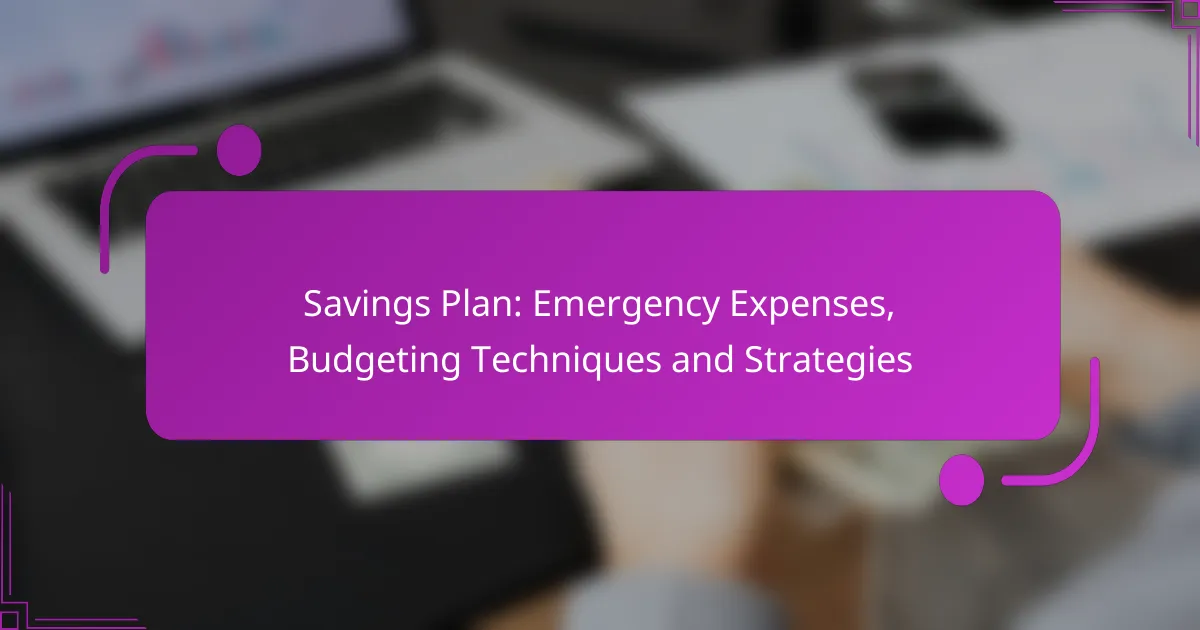Establishing a savings plan for emergency expenses is crucial for financial security, as it prepares you for unexpected costs without causing stress. By employing effective budgeting techniques and strategies, you can allocate your resources wisely, ensuring that you not only save for emergencies but also maintain control over your overall spending. With a focus on cutting unnecessary expenses and exploring additional income sources, you can build a robust financial cushion that provides peace of mind.

How to create a savings plan for emergency expenses?
Creating a savings plan for emergency expenses involves identifying essential costs, setting a target amount, and establishing a regular contribution. This plan ensures you have funds available for unexpected situations, helping to avoid financial stress.
Identify essential expenses
Start by listing your essential expenses, which are the costs you cannot avoid, such as housing, utilities, groceries, and healthcare. These expenses typically remain constant and should be prioritized in your savings plan.
Consider including variable expenses that can arise unexpectedly, like car repairs or medical bills. A good rule of thumb is to aim for three to six months’ worth of essential expenses in your emergency fund.
Set a target savings amount
Your target savings amount should reflect the total of your essential expenses for a set period, commonly three to six months. This range provides a safety net for unforeseen circumstances.
To determine your specific target, calculate your monthly essential expenses and multiply by the number of months you want to cover. For instance, if your monthly expenses are $2,000, aim for a savings goal between $6,000 and $12,000.
Choose a savings account
Select a savings account that offers easy access to your funds while providing some interest. High-yield savings accounts or money market accounts are often good choices, as they typically offer better interest rates than standard savings accounts.
Ensure the account is FDIC-insured if you are in the United States, which protects your deposits up to $250,000. This security is crucial for long-term savings plans.
Establish a monthly contribution
Determine how much you can contribute to your savings each month based on your budget. A common approach is to allocate 10-20% of your monthly income towards your emergency fund until you reach your target amount.
Automate your contributions by setting up a direct deposit or automatic transfer from your checking account. This method helps to ensure consistency and makes saving easier.
Review and adjust regularly
Regularly review your savings plan to ensure it aligns with your current financial situation and goals. Adjust your target amount or monthly contributions as necessary, especially if your income or expenses change.
Consider conducting a review every six months or annually. This practice allows you to stay on track and make informed decisions about your savings strategy.

What budgeting techniques can help manage savings?
Effective budgeting techniques can significantly enhance your ability to manage savings, especially for emergency expenses. By implementing structured methods, you can allocate your income wisely, ensuring that you set aside funds for unexpected costs while maintaining control over your spending.
Zero-based budgeting
Zero-based budgeting requires you to allocate every dollar of your income to specific expenses, savings, or debt repayment, leaving a balance of zero at the end of the month. This method encourages careful tracking of all expenditures, making you more aware of your financial habits.
To implement zero-based budgeting, list all income sources and categorize every expense, including savings goals. This approach can help identify unnecessary spending and prioritize essential costs, ensuring that you are always working towards your financial objectives.
50/30/20 rule
The 50/30/20 rule is a straightforward budgeting technique that divides your after-tax income into three categories: 50% for needs, 30% for wants, and 20% for savings and debt repayment. This method simplifies the budgeting process and helps maintain a balanced financial life.
For example, if your monthly income is $3,000, allocate $1,500 for needs (like housing and groceries), $900 for wants (such as entertainment), and $600 for savings or debt. This rule provides a clear framework to ensure you are saving adequately while still enjoying discretionary spending.
Envelope system
The envelope system involves using physical envelopes to manage cash for different spending categories. Each envelope represents a specific budget category, and once the cash in an envelope is gone, you cannot spend any more in that category for the month.
This method is particularly effective for controlling discretionary spending, such as dining out or entertainment. By limiting your spending to the cash available in each envelope, you can avoid overspending and ensure that you stick to your savings goals.
Automated savings
Automated savings involves setting up automatic transfers from your checking account to a savings account, ensuring that a portion of your income is saved without requiring manual effort. This strategy can help you build an emergency fund more effectively by treating savings as a non-negotiable expense.
To start, determine a reasonable amount to save each month and set up automatic transfers accordingly. Many banks offer tools to facilitate this process, making it easier to achieve your savings goals without the temptation to spend that money instead.

What strategies can maximize savings for emergencies?
To maximize savings for emergencies, focus on cutting unnecessary expenses, increasing your income, and utilizing cash-back and rewards programs. These strategies can help you build a financial cushion more effectively and efficiently.
Cut unnecessary expenses
Start by reviewing your monthly expenses to identify areas where you can cut back. Common categories include dining out, subscription services, and impulse purchases. Aim to reduce these costs by at least 10-20% to free up more funds for your emergency savings.
Consider implementing a budgeting technique, such as the 50/30/20 rule, where 50% of your income goes to needs, 30% to wants, and 20% to savings. This method can help you prioritize your spending and ensure that you allocate enough for emergencies.
Increase income through side hustles
Exploring side hustles can significantly boost your income and enhance your emergency savings. Options include freelance work, tutoring, or selling handmade goods online. Many people find they can earn an additional few hundred dollars each month through part-time efforts.
When choosing a side hustle, consider your skills and interests to ensure it is sustainable. Aim for opportunities that offer flexibility, allowing you to balance your primary job and personal life while still contributing to your savings goals.
Utilize cash-back and rewards programs
Cash-back and rewards programs can provide additional savings on everyday purchases. Many credit cards offer cash-back incentives, while retailers may have loyalty programs that reward frequent shoppers. By using these programs strategically, you can earn money back on purchases you would make anyway.
To maximize benefits, research and compare different programs to find those that align with your spending habits. Set a goal to earn a specific amount each month through these rewards, and consider using the cash-back earnings directly for your emergency fund.

What are the common pitfalls in savings plans?
Common pitfalls in savings plans can derail your financial goals and lead to insufficient funds for emergencies. Recognizing these challenges is crucial for maintaining a successful savings strategy.
Underestimating expenses
Underestimating expenses is a frequent mistake that can hinder your savings efforts. Many individuals fail to account for irregular costs such as medical bills, car repairs, or home maintenance, which can add up significantly over time.
To avoid this pitfall, create a comprehensive budget that includes both fixed and variable expenses. Consider using a budgeting app or spreadsheet to track all potential costs, ensuring you allocate enough funds for unexpected expenses.
Inconsistent contributions
Inconsistent contributions to your savings plan can lead to inadequate funds when emergencies arise. Many people struggle to set aside a regular amount, often due to fluctuating income or lack of discipline.
To combat this issue, automate your savings by setting up direct deposits from your paycheck into a dedicated savings account. Aim to contribute a consistent percentage of your income, even if it’s a small amount, to build a habit of saving.
Neglecting to review the plan
Neglecting to review your savings plan can result in outdated strategies that no longer align with your financial situation. Regular assessments are essential to ensure your plan remains effective and relevant.
Schedule periodic reviews—at least once a year—to evaluate your savings goals, contributions, and overall financial health. Adjust your plan as necessary to reflect changes in income, expenses, or financial objectives, keeping your savings on track.



